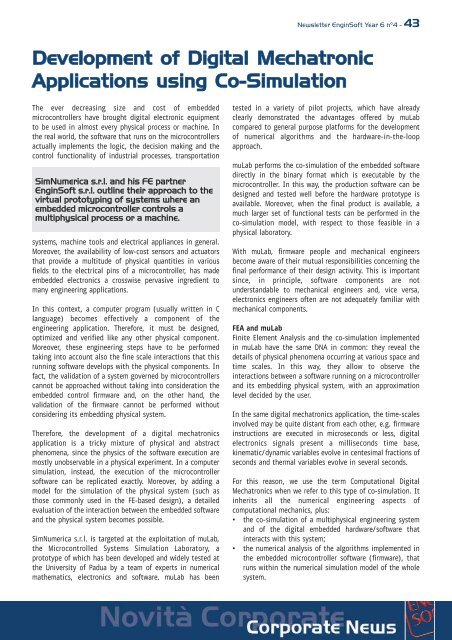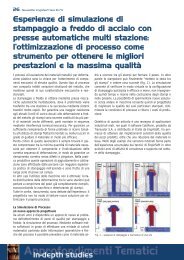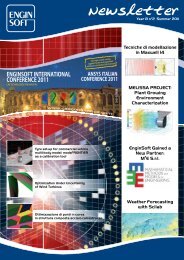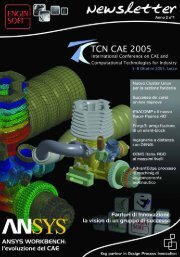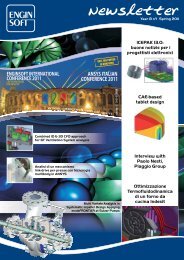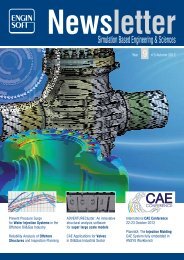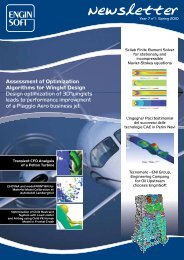software training courses 2010 corsi di addestramento ... - EnginSoft
software training courses 2010 corsi di addestramento ... - EnginSoft
software training courses 2010 corsi di addestramento ... - EnginSoft
Create successful ePaper yourself
Turn your PDF publications into a flip-book with our unique Google optimized e-Paper software.
Newsletter <strong>EnginSoft</strong> Year 6 n°4 - 43<br />
Development of Digital Mechatronic<br />
Applications using Co-Simulation<br />
The ever decreasing size and cost of embedded<br />
microcontrollers have brought <strong>di</strong>gital electronic equipment<br />
to be used in almost every physical process or machine. In<br />
the real world, the <strong>software</strong> that runs on the microcontrollers<br />
actually implements the logic, the decision making and the<br />
control functionality of industrial processes, transportation<br />
SimNumerica s.r.l. and his FE partner<br />
<strong>EnginSoft</strong> s.r.l. outline their approach to the<br />
virtual prototyping of systems where an<br />
embedded microcontroller controls a<br />
multiphysical process or a machine.<br />
systems, machine tools and electrical appliances in general.<br />
Moreover, the availability of low-cost sensors and actuators<br />
that provide a multitude of physical quantities in various<br />
fields to the electrical pins of a microcontroller, has made<br />
embedded electronics a crosswise pervasive ingre<strong>di</strong>ent to<br />
many engineering applications.<br />
In this context, a computer program (usually written in C<br />
language) becomes effectively a component of the<br />
engineering application. Therefore, it must be designed,<br />
optimized and verified like any other physical component.<br />
Moreover, these engineering steps have to be performed<br />
taking into account also the fine scale interactions that this<br />
running <strong>software</strong> develops with the physical components. In<br />
fact, the validation of a system governed by microcontrollers<br />
cannot be approached without taking into consideration the<br />
embedded control firmware and, on the other hand, the<br />
validation of the firmware cannot be performed without<br />
considering its embed<strong>di</strong>ng physical system.<br />
Therefore, the development of a <strong>di</strong>gital mechatronics<br />
application is a tricky mixture of physical and abstract<br />
phenomena, since the physics of the <strong>software</strong> execution are<br />
mostly unobservable in a physical experiment. In a computer<br />
simulation, instead, the execution of the microcontroller<br />
<strong>software</strong> can be replicated exactly. Moreover, by ad<strong>di</strong>ng a<br />
model for the simulation of the physical system (such as<br />
those commonly used in the FE-based design), a detailed<br />
evaluation of the interaction between the embedded <strong>software</strong><br />
and the physical system becomes possible.<br />
SimNumerica s.r.l. is targeted at the exploitation of muLab,<br />
the Microcontrolled Systems Simulation Laboratory, a<br />
prototype of which has been developed and widely tested at<br />
the University of Padua by a team of experts in numerical<br />
mathematics, electronics and <strong>software</strong>. muLab has been<br />
tested in a variety of pilot projects, which have already<br />
clearly demonstrated the advantages offered by muLab<br />
compared to general purpose platforms for the development<br />
of numerical algorithms and the hardware-in-the-loop<br />
approach.<br />
muLab performs the co-simulation of the embedded <strong>software</strong><br />
<strong>di</strong>rectly in the binary format which is executable by the<br />
microcontroller. In this way, the production <strong>software</strong> can be<br />
designed and tested well before the hardware prototype is<br />
available. Moreover, when the final product is available, a<br />
much larger set of functional tests can be performed in the<br />
co-simulation model, with respect to those feasible in a<br />
physical laboratory.<br />
With muLab, firmware people and mechanical engineers<br />
become aware of their mutual responsibilities concerning the<br />
final performance of their design activity. This is important<br />
since, in principle, <strong>software</strong> components are not<br />
understandable to mechanical engineers and, vice versa,<br />
electronics engineers often are not adequately familiar with<br />
mechanical components.<br />
FEA and muLab<br />
Finite Element Analysis and the co-simulation implemented<br />
in muLab have the same DNA in common: they reveal the<br />
details of physical phenomena occurring at various space and<br />
time scales. In this way, they allow to observe the<br />
interactions between a <strong>software</strong> running on a microcontroller<br />
and its embed<strong>di</strong>ng physical system, with an approximation<br />
level decided by the user.<br />
In the same <strong>di</strong>gital mechatronics application, the time-scales<br />
involved may be quite <strong>di</strong>stant from each other, e.g. firmware<br />
instructions are executed in microseconds or less, <strong>di</strong>gital<br />
electronics signals present a milliseconds time base,<br />
kinematic/dynamic variables evolve in centesimal fractions of<br />
seconds and thermal variables evolve in several seconds.<br />
For this reason, we use the term Computational Digital<br />
Mechatronics when we refer to this type of co-simulation. It<br />
inherits all the numerical engineering aspects of<br />
computational mechanics, plus:<br />
the co-simulation of a multiphysical engineering system<br />
and of the <strong>di</strong>gital embedded hardware/<strong>software</strong> that<br />
interacts with this system;<br />
the numerical analysis of the algorithms implemented in<br />
the embedded microcontroller <strong>software</strong> (firmware), that<br />
runs within the numerical simulation model of the whole<br />
system.


